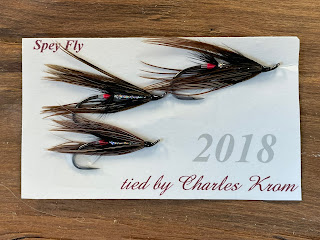Several weeks ago, Linda Warren (fishing and life partner of the late Bob Warren) invited me to help her have a look at Bob's fly fishing estate, if you will. We had a fine time, I think, opening cigar boxes and tub after tub of goodies. Knowing of my interest in preserving the legacies of fly tyers who made a difference, she generously gave me any flies we thought would/should/could be preserved for future fly tying generations to ponder. What she gave me will end up on the walls of the Atlantic Salmon Museum in Doaktown, NB, Canada just to ensure those future ponderings. Bob had a long relationship with Charlie Krom and Keith Fulsher...far longer than I was privileged to enjoy their company and tying lessons. I did a previous blog post on Fulsher, Krom and Warren. Sadly, all three men have gone to their reward. Go here: https://theriverscourse.blogspot.com/2014/03/fulsher-krom-and-warren.html
I also did a brief update on Charlie Krom's tying activities: https://theriverscourse.blogspot.com/2018/01/the-latest-from-charlie-krom.html
Keith Fulsher created the Thunder Creek minnow series and published a book about them. Don't forget that you can click on the pics for a larger version of it!
Now we have a couple beautiful examples of those flies to care for:
In the book:
Known to every hair wing Atlantic salmon fly tyer worth her or his salt (I know there are other pronouns around these days, I just don't know what they are) , Fulsher and Krom's Hair-wing Atlantic Salmon Flies is, by most standards, the, uh, standard for modern hair-wing recipes. It also contains a short history of what the guys considered the development of the hair-wing salmon fly.
I treasure my first copy (I have three; this one for the library shelf, and one at each tying bench in Vermont and New Brunswick). Note: they used to be expensive, now they are not. Pretty easy to pick up an unsigned copy for twenty bucks or less).
And a smattering of Charlie's other inspiring flies built in his 80's:






























































